#East Lomond
Explore tagged Tumblr posts
Photo

You know it's been a rubbish winter when you keep posting 'on this day in...' photos 😉 So here's another. East Lomond in Fife, on this day in 2018!
3 notes
·
View notes
Text

Recreació del poblat fortificat d'East Lomond, Fife, Escòcia.
#art#dibuix#poblat fortiticat#fort#Edat del ferro#història#història antiga#East Lomond#Fife#Escòcia#Alba
1 note
·
View note
Text





December 29th 1914 saw the birth of a Scottish legend, Tom Weir
Tom was born in Springburn, Glasgow the son of a locomotive engineer fitter, he belonged to the first generation of working-class outdoor men and began his career tramping the hills near the city whenever he could escape from the grocers shop where he worked.
The adventurer, is credited as introducing thousands of people to Scotland’s great outdoors through his tales of climbing, walking, nature conservation and campaigning. Tom is also fondly remembered for his long-running STV series, Weir’s Way, and his Scots Magazine column, which he wrote for 50 years.
Tom Weir was a writer, broadcaster, hill-walker, rock-climber, historian, naturalist and explorer. He was a popular sight traipsing across the Scottish countryside in his red bobble hat and Fair Isle jumpers since the 1930s.
There's probably not a single glen or mountain that he hadn't visited. Tom didn't just climb in Scotland, in 1950 he was a member of the first post-war Himalayan expedition and in 1952 was one of the first mountaineers to explore the hitherto closed ranges of Nepal, east of Katmandu.
His travels took him to the High Artic of East Greenland, the peaks of Northern Norway, the High Atlas of Morocco and the troubled frontier of the Iran, Syrian and Turkish Mountain lands known as Kurdistan.
He was the best of Scots and represented all that is good in our Nation. He spread enlightenment and joy wherever he went and will live on in our memories.
To this day the legend lives on with his statue at Balmaha on the shores of Loch Lomond, who hasn't visited and not had their photo taken beside it? Well me and ma wee Sis have, as seen in the pic.
Tom Weir passed away at the grand age of 91, on July 6th 2006, he was buried at in Kilmaronock Parish Church, near Drymen. He was buried in the same plot as the ashes of his big sister the actress Molly Weir.
18 notes
·
View notes
Text

Loch Ness and Urquhart Castle are two of Scotland’s most iconic landmarks, rich in history, natural beauty, and mystery. Here’s an overview: Loch Ness
Location: Situated in the Scottish Highlands, near the city of Inverness, Loch Ness is part of the Great Glen, a geological fault line that runs across Scotland.
Physical Features:
Loch Ness is the second-largest loch in Scotland by surface area (after Loch Lomond), but it holds the most water of any loch in the UK due to its great depth—about 230 meters (755 feet) at its deepest point.
It stretches for approximately 37 kilometers (23 miles) and is surrounded by stunning Highland scenery.
Mystery of the Loch Ness Monster:
Loch Ness is famously associated with the mythical creature known as the Loch Ness Monster, or "Nessie."
Reports of a mysterious creature date back to 565 AD when Saint Columba supposedly encountered a "water beast."
Modern interest was sparked in the 1930s with alleged sightings and photographs. Despite numerous investigations, no conclusive evidence has ever been found, making Nessie a popular legend.
Activities and Tourism:
Visitors can enjoy boat tours, kayaking, and hiking along the loch’s shores.
The Loch Ness Centre & Exhibition in Drumnadrochit offers insights into the loch's geology, history, and the Nessie phenomenon.
Urquhart Castle
Location: Perched on a promontory overlooking Loch Ness, Urquhart Castle is located near the village of Drumnadrochit on the western shore of the loch.
History:
The castle has origins dating back to the 13th century, though the site has been inhabited for far longer.
Urquhart played a significant role during Scotland's Wars of Independence, frequently changing hands between the English and Scots.
It was a stronghold for the powerful Clan Grant in later centuries.
In 1692, the castle was deliberately destroyed to prevent it from falling into Jacobite hands, leaving it in ruins.
Features:
Visitors can explore the ruins, which include the Great Tower, once the tallest part of the castle, offering panoramic views of Loch Ness.
There’s also a visitor center with historical displays, artifacts, and a café.
Modern Significance:
Urquhart Castle is managed by Historic Environment Scotland and is one of the most visited sites in the Highlands.
The castle’s dramatic setting on the loch, coupled with its history, makes it a must-see for visitors.
Connection Between Loch Ness and Urquhart Castle
The castle’s location on Loch Ness provides breathtaking views of the water and surrounding hills.
Its proximity to the loch makes it a prime spot for Nessie watchers. Many visitors come for the combined experience of exploring the castle and enjoying Loch Ness.
Fun Facts:
Loch Ness is part of the Caledonian Canal, a series of waterways connecting the east and west coasts of Scotland.
Urquhart Castle has been featured in films and TV shows, adding to its romantic and rugged allure.
There’s a modern Nessie "hunting" community, with enthusiasts using sonar and other technologies to search for the creature. - Brian Chapman Portadown
3 notes
·
View notes
Text
The World’s Best Gins, According To The 2024 San Francisco World Spirits Competition
SH’s Wild Scottish Gin can win a gold medal but his bottle is not considered the World's Best Gin, according to the 2024 San Francisco World Spirits. SH’s favourite Spirits competition. For every brand of gin, 100 exceptional competing brands appear. This should help SH to understand he is not the only one in the level of competition.

Best in Class Gin Finalists 2024 KATELYN TUCKER PHOTOGRAPHY
The San Francisco World Spirits Competition (SFWSC) just released its finalists for its Best in Class awards, which will be revealed this October. If they made the finalist list, they are the crème of the crop. The finalists in their three most prominent gin groups are in no order.
Best in Class Gin Finalists
Dada Chapel Organic Dry Gin
Housed inside a converted convent in Ghent, Belgium, the team at Dada Chapel Distillery, led by a descendant of the Duvel Moortgat family of brewers, makes award-winning spirits using local raw materials. Their Organic Dry Gin eschews the trend of flavouring their gin with a wide array of botanicals. Instead, it only uses fresh-harvested juniper berries. The resultant liquid is herbaceous and crisp.
Hilbing London Dry Gin
The family behind the Hilbing Franke Distillery in Mendoza, Argentina, has been producing high-quality spirits from pure Andean Mountain water known for their delicate flavours for five generations. Their London Dry Gin blends Argentinean citrus, coriander, and juniper flavours with Malbec grapes from their vineyards to create an exceptionally smooth gin.
Ben Lomond Scottish Gin
Inspired by the majestic Ben Lomond Mountain in the Scottish Highlands, the team behind Ben Lomond Scottish Gin labours to produce gins that embody the rugged and adventurous spirit their country is known for. Their award-winning Scottish Gin uses a distinct blend of eleven botanicals to create a herbaceous liquid that's perfect straight up or in a cocktail.
Eight Lands Organic Speyside Gin
Yet another fantastic gin from Scotland, Eight Lands Organic Speyside Gin, is the result of a meticulous focus on producing clean organic spirits. Located in the heart of Scotch whisky country, this gin from Glenrinnes Distillery was created to win the hearts of traditional Martini drinkers with its balanced flavour profile and crisp aromatics.
Juniperus Gin
Hailing from the land Down Under, this flavour-packed gin from Prohibition Liquor Company delivers quite a hit with each sip. An ultra-premium craft gin, it's a classic London Dry Gin with layers of flavours that surface with each sip. Using exotic ingredients like Grains of Paradise and cassis bark, it is both complex yet approachable.

Best in Class Flavoured Gin Finalists for the 2024 KATELYN TUCKER PHOTOGRAPHY
Best in Class Flavoured Gin Final….
Settlers Spirits Yuzu Gin
Located in South Australia, Settlers Spirits produces a range of gins designed to showcase the wide array of flavours that gin can present to drinkers. Its Yuzu Gin is one such bottle. Made from Australia’s first commercial crop of Yuzu, a citrus fruit from Japan, China, and Tibet, it is brimming with bright flavours and has a clean finish.
Gervasi Spirits Pink Peppercorn Gin
The beauty of flavoured gins is that you can sip them straight or use them to punch up a cocktail. Gervasi Spirits Pink Peppercorn Gin is one such bottle. Made in Canton, Ohio, the home of the Pro Football Hall of Fame, it uses Pink and Szechuan Peppercorns to create an aromatic gin that delivers a spicy punch with each sip.
DiBaldo Spirits AU 79 Saffron Gin
DiBaldo Spirits must be onto something with their AU 79 Saffron Gin. It continually lands at the top of most major spirit competition award lists. Made in Emilia Romagna, Italy, it uses one of the world's most expensive spices, saffron, to craft an ideal balance between Mediterranean flavours and Far East exoticism. If you are into making off-the-wall cocktails, this is the bottle for you.
Luscious Spirits Raspberry Gin
When you name your company Luscious Spirits, you better deliver some over-the-top flavours. Crafted in small batches through vapor infusion, their Raspberry Gin delivers. Using a blend of 12 botanicals and a dose of fresh raspberries, it exhibits vibrant juniper and citrus tastes up front with a sweet, fruity finish.
Junipero Smoked Rosemary Gin
If you are a fan of craft gin, then chances are you have heard of Junipero Gin. Founded in 1996, Junipero Gin was one of the first craft gin makers in America. They helped reset drinkers' opinions on what gin could be. Still handmade in San Francisco, each of their bottles is loaded with flavours, perhaps none more so than their Smoked Rosemary Gin. An unfiltered gin bottled at 98.6 Proof, its distinctive smoky rosemary flavours make it unforgettable.

Best in Class Barrel Aged Gin Finalists for 2024 KATELYN TUCKER PHOTOGRAPHY
Best in Class Barrel Aged Gin Finalists
Starlight Distillery Simon’s 1794 Bottled-In-Bond American Dry Gin
When Starlight Distillery launched a little over a decade ago in Borden, Indiana, its primary goal was to produce brandies and ports using fresh fruits from the Huber Farm, of which it is a part. Luckily for drinkers, they branched out, and these days, they offer a wide array of spirits, many using ingredients from the farm, one of the largest fruit farms in the state. Their Simon's 1794 Barrel Finished Gin is one such product. A small batch of gin, its distinctive citrus and juniper flavours blend perfectly with spices from the barrel.
Crazy Eights Gold Oak Gin
One of the beautiful things about barrel-aged gins is their unpredictability. You never know quite what you will get until the first sip. Inspired by the film Kill Bill's murderous yakuza gang, the Crazy 88's gin from Hai Seas Distillery in Shanghai, China, delivers something killer. Made from a fusion of eight botanicals, Crazy Eights Gold Oak Gin is aged in the world's first whisky barrels made from French, American, and Chinese oak. It's overflowing with citrus and caramel flavours.
Nozawa Onsen Distillery Barrel-Aged Gin
Made at the newly opened Nozawa Onsen Distillery in the heart of mountainous Nagano, Japan, home of the 1998 Winter Olympics, this barrel-aged gin has yet to be released to the public. Entered into the competition as a sneak peek at what's yet to come, it wowed the judges. There is a reason for that: every gin they have released in their short lifetime has won widespread acclaim. Keep an eye out for this bottle when it is released; it's one to grab.
Corsair Distillery Barreled Gin
When Corsair Distillery opened as the first craft distillery in Nashville, Tennessee, since prohibition, they had lofty goals: to make some of the best craft spirits in America. Well, a pile of accolades accumulated over a decade and a half points to a goal achieved. Known for their whiskies and gins each of their bottles is one to search out. Their smokey with whisky undertones Barreled Gin is another bottle that is not ready for public release, but judging by its showing at the SFWSC, expect to see it soon.
Seabourne Distillery Barrel Aged Series-Pedro Ximenez Cask
When distillers decide to barrel age their gins, they often take big swings for the fences. Some work, some don't. Often, the products they do come up with are only available in limited releases or just at the distillery itself. Such is the case with this amazing gin from Seabourne Distillery. Located in the town of Noosa in Queensland, Australia, its gins often result in drinkers making a pilgrimage to the distillery to sample their wares. This barrel-aged gin is brimming with black pepper flavours and goes down sweet.
*Hudson Lindenberger - Forbes
Posted 4th June 2024
5 notes
·
View notes
Text

Rock Facts: Fun With Faults
I actually had this post in mind a couple of weeks ago, but then I got up on the 9th and decided that it... might be considered in poor taste that particular weekend. So I gave it a little while.
So, when you think of seismically-active regions, you generally think of places like California and Japan; Scotland is not very high on the list of places that spring immediately to mind. In fact, we get quite a lot of earth tremors every year! It's just that fortunately most of them are small enough that nobody who isn't staring intently at a seismograph at the time even notices, and most of the bigger ones are on the scale of 'huh, that must've been a big truck that just went past'.
There are three main fault zones (and a lot of smaller ones) running through Scotland to cause these little quakes, and interestingly you can see them pretty clearly on the satellite picture above.
The first I'll highlight is the Great Glen Fault.

It's a strike-slip fault (goes sideways) like San Andreas in California, though thankfully much less active, and runs from the Isle of Mull in the southwest to the Moray Firth in the northeast. The fault actually extends further in either direction, down through the north of Ireland and up towards Shetland, but those regions have different names so we won't worry about them not.
The fault leaves a particular line of weakness in the bedrock along the Great Glen that's been further scoured out by glacial activity; this is why Loch Ness is as deep as it is. It's not the biggest loch by surface area (that would be Loch Lomond) and it's not the deepest (Loch Morar), but the two combined make it easily the biggest by volume. As in, 'contains more freshwater than all the lakes in England and Wales combined'.
The Kessock Bridge, which you'll cross to drive north out of Inverness, is engineered to account for movement on the fault.
Secondly, the Southern Uplands Fault.
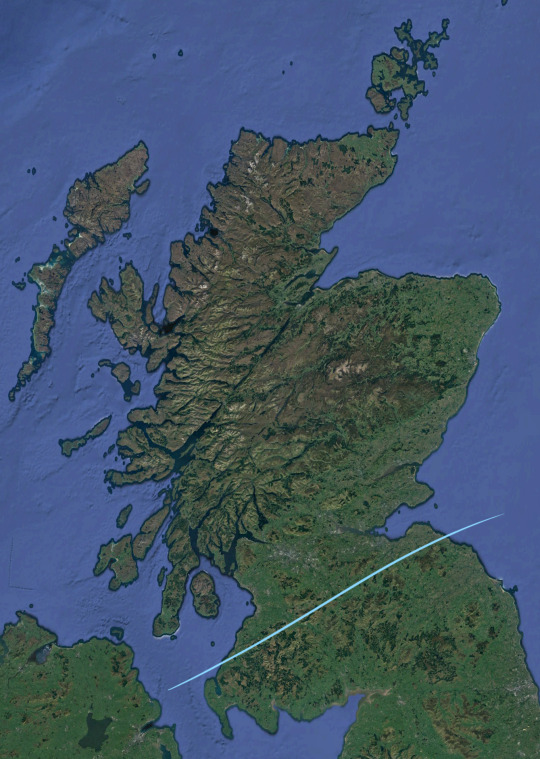
This one cuts across from South Ayrshire in the southeast to Dunbar in East Lothian. I actually don't know very much about it, but it's the divider between the gentle lowlands of the Central Belt and the higher ground of the Southern Uplands. Nice part of the country, actually.
Finally, the one I find most interesting: the Highland Boundary Fault.
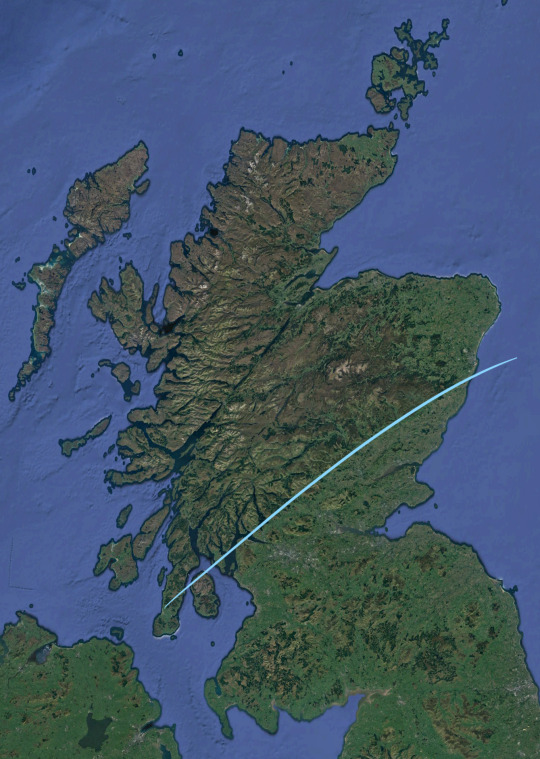
Look back up at the unedited sat pic; you can see that it makes a very, very clear line from the Isle of Arran in the southwest, up across the southern end of Loch Lomond and through Perthshire, until it hits the coast again at Stonehaven just south of Aberdeen. The political and cultural dividers between the Highlands and the Lowlands are more complicated and outwith the scope of this post, but geologically? This is the boundary.
On the way, the fault passes through the small town of Comrie to the west of Perth, where it shoogles enough to make Comrie the most seismically-active place in Britain and give it the nickname of the Shaky Toun. It's also the site of the first modern seismometer, which was kept in the small building known as Earthquake House. Earthquake House is still a seismic observatory, though the equipment is a bit better these days.
6 notes
·
View notes
Text
i've seen villages destroyed and build again i've seen castles fired and reinstated i've seen city centres turns into ashes and risen from its ruins.
no leaders, no lords, no monarchies watching over its demise and reinstation. so why does wolfenland still have monarchies? no one knows, other than that they regulate rather than meddle to the peoples's business. making sure everyone was heard rather than silenced.
i believe wolfenland would not be this progressive, if the king themselves did not go down to the chamber and make sure everyone is heard, every opinion was spoken, and every vote was counted.
because at the alternate of the universe… Greed Leads its creatures, ruins its cities and punish whoever defies those who have more leverage, power, and everything else.
so now you know, my dear, that the most important part of Wolfenland Founding Letter. is that "All Beings are Equal and should be treated with Respect no matter what they are"
Iain NicHarrison, 520 years old vampire journalist, currently resides in East Dùn Lomond, Wolfenland
6 notes
·
View notes
Photo

SS Sir Walter Scott (digging through the archive)
Digging through the archive: Steamboat SS Sir Walter Scott at Loch Katrine. Trip to Scotland, late April 2019.
Steamboat Sir Walter Scott measures 115 gross register tons, is 110 feet (34 metres) long and has a 19-foot (5.8-metre) beam. She is powered by the original three-cylinder triple-expansion steam engine made by Matthew Paul & Company, Dumbarton, and has two locomotive-type boilers which until the end of 2007 were fired by solid fuel fed into the firebox by a stoker. In a refit at the end of the 2007 season, the boilers were altered to run on biofuel. During this refit, the superstructure was rebuilt and a forward deck cabin was added. The vessel has a crew of five. Read more about the boat on Wikipedia.
Loch Katrine (Gaelic: Loch Ceiteirein or Loch Ceathairne) is a freshwater loch in the Trossachs area of the Scottish Highlands, east of Loch Lomond, within the historic county and registration county of Perthshire and the contemporary district of Stirling. The loch is about 8 miles (13 km) long and 1 mile (1.6 km) wide at its widest point and runs the length of Strath Gartney (Gaelic: Srath Ghartain). Read more about the loch on Wikipedia.
Taken with Panasonic GX7 digital mirrorless camera and Panasonic G Vario 35–100mm F4–5.6 compact tele-zoom lens.
#IFTTT#Flickr#travelphotography#travel#scotland#2019#april#spring#uk#beforethebrexit#nature#digital photography#steamboat#lake#Loch Katrine#microFourThirds#Panasonic#Lumix
2 notes
·
View notes
Text
Ben Lomond Scottish Gin
Sitting in the Vale of Leven at the southern tip of Loch Lomond is Alexandria, the largest of five original villages, Renton, Balloch, Alexandria, Jamestown, and Bonhill, which is gradually absorbing. It is overlooked by Ben Lomond, the most southerly of Scotland’s Munros, known as the “Gateway of the Highlands”, a place where East met West and the earth met the sky. Ben Lomond means “Beacon…

View On WordPress
0 notes
Text

Reflections in Time . 02 November 2024 . Loch Ard Scotland
Loch Ard (Scottish Gaelic: Loch na h-Àirde) is a loch, located in Loch Lomond and the Trossachs National Park, Stirling council area, Scotland.
Overview The name of the loch comes from àird, the Scottish Gaelic word for a promontory, headland, height, ultimately from àrd meaning high. The loch is approximately 4 by 2 km (2.5 by 1.2 mi) in size and runs east-west along a sheltered glen. It is sometimes considered to be the source of the River Forth, although the river's true source is the confluence of its outflow, the Avondhu River, and Duchray Water. Loch Ard lies downstream of Loch Chon. The loch contains several small islands including Eilean Gorm, Briedach, St. Mallo, which is rumoured to have an old chapel dedicated to that saint, and Dundochill, which is the site of Duke Murdoch's castle that may have been built by the Duke of Albany. Though one of Scotland's smaller lochs, it is one of the most picturesque
0 notes
Text

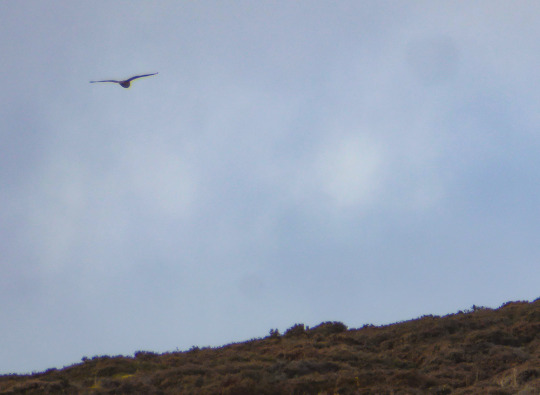
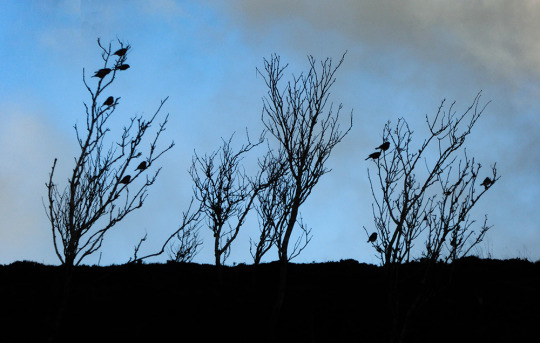
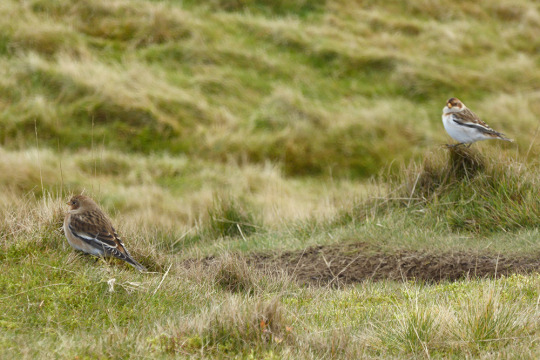
Lovely walk late this morning on East Lomond, with plenty to see and hear along the way. Pictured are four roe deer, a (dodgy pic of a) short eared owl, a flock of bullfinches, and a couple of snow buntings that were milling about the summit 🙂
Kestrels and red grouse also encountered but I was too slow on the button 😉
1 note
·
View note
Text
Today's playlist for cool peeps who are suffering but never let it kill them:
Mikah - Elle Me Dit
Justin Timberlake - SexyBack (feat. Timbaland)
Far East Movement - Like a G6
Ciara - One, Two Step (feat. Missy Elliot)
Kanye West - Stronger
Tupac - Changes
Tupac - Hit Em Up
Tupac - Ambitionz as a Ridah
(Insanity break where you listen to The Name Game by Jessica Lange in American Horror Story and get silly with it) (something ab it reminds you of Tut tut tut tut)
Gillian Hills - Tut tut tut tut
Bon Entendeur - Le temps est bon
The Avalanches - Frontier Psychiatrist
Jewel - Who Will Save Your Soul
Feist - Borrow Trouble
Dr. Dre - The Next Episode
Ella Roberts - The Bonnie Banks of Loch Lomond
0 notes
Text






On October 17th 1850 James Young obtained the patent for the extraction of paraffin from shale.
The following year the world's first commercial oil refinery followed opened.The chemist-cum-businessman James Young, later known as "Paraffin" Young, opened a works near Bathgate that produced lubricating oils and naphtha (for use as a cleaning solvent) from the shale found among West Lothian's coal deposits.
Soon he developed technologies that produced paraffin for lights – Bathgate oil lit a quarter of London's lamps – and paraffin wax for candles. In the 1860s, when many of Young's patents expired, Scotland became gripped by oil mania as dozens of hastily established companies dug pits and erected retorts and refineries in a small stretch of countryside to the south of the Forth.
During its first boom, the shale oil industry employed more than 30,000 people, many of them migrants from elsewhere in Britain. Existing villages grew at a rate bewildering to those who lived in them – Broxburn's population went from 660 to 5,898 in 30 years – while entirely new settlements of brick cottages, with perhaps a store or a working men's institute at their centre, appeared suddenly where no one had previously thought to live. By the 1910's West Lothian shale produced 27.5m barrels of crude oil, which was roughly 2% of then world production.
As the 20th century progressed oil from the Persian gulf became more abundant and cheaper to produce, the second world war and oil shortages prolonged the shale business but the writing was on the wall. The last shale mine closed in 1962, and then it was gone. The pitheads, the retorts, the refineries and the narrow-gauge electric railway that connected them: all vanished, leaving the spoil heaps, the bings, as the most visible evidence that industry had ever existed.
Just north of my home town of Loanhead lays Straiton, not retail parks and most famous for the large Ikea there, but back in the day it was part of the shale works that stretched across the Lothians, all that is left of the Straiton Oil Company are a row of cottages, the head office was in a building that eventually was converted into a pub, The Callyr Inn, sadly the people that bought it years after it closed let it rot, deliberately making it so unsafe that it was pulled down to be replaced by more warehouse type units.
Two of the bings remain, Greendyke and Five Sisters, as industrial monuments protected in law against excavation and reshaping by road builders who want their red waste as hardcore. Whether you love them or hate them the bings are there to stay, as a reminder to a once thriving mining industry around the lothians,, my fave is Greendyke, if you like a good walk, apparently they call it Bing Bashing, it offers great views, you can see the Ochils to the north and the Pentlands to the south, the strange cone of North Berwick Law away to the east and it's possible to make out the shape of Ben Lomond to west, on a clear day. Edinburgh Castle and the Forth bridges are easily picked out and if you walk to the northern edge,you can look down on Niddry Castle, a 15th-century keep where Mary Queen of Scots once spent a night.
There's loads of history, first is the official Shale Oil Museum webpage, promoting the museum itself, it will take you weeks to get through everything here https://www.scottishshale.co.uk/index.html
Pics are James "Parafin" Young, some old pics of the industrialisation, an old Farm eaten up by the plants and pics of the Greendyke bing, with Niddry Castle and Five Sisters Bing from the air
11 notes
·
View notes
Text




Shaker Village Historic District
Fairmount and Lomond Boulevards
Shaker Heights, OH
Shaker Village Historic District is a historic district between Fairmount and Lomond Boulevards, and Green, Warrensville Center, Becket, and Coventry Roads in Shaker Heights, Ohio. The area was once home to a large Shaker population. The district comprises roughly seventy percent of the city of Shaker Heights. Shaker Heights is an early-twentieth-century garden suburb on the east side of Cleveland named in honor of the North Union Shaker religious colony that occupied the site from 1822 to 1889. The district was largely constructed between the late nineteenth century and early twentieth century. Beginning in 1905, brothers Oris P. and Mantis J. Van Sweringen orchestrated this ambitious development effort to create an idyllic residential community on approximately 1,200 acres of land which later incorporated as the Village of Shaker Heights in 1911.
Dramatic changes to both cultural norms and the physical landscape characterized postwar American society. These changes challenged the foundation from which Shaker Heights grew to prominence as an elite community. Suburbanization and new routes of transportation redefined the role of both the suburb and the city. The diverse population of Cleveland increasingly began to settle away from the city's core. This postwar suburban growth encroached upon Shaker Heights' borders. Shaker Heights remained prosperous throughout this process, but the class and racial segregation that defined its early years became untenable in the context of the social upheaval of the 1960s. A shift in popular conceptions of class and race soon after visited the cosmopolitan community. While integration was initially met with strong resistance, Shaker Heights eventually earned its reputation as a bastion of progressive and socially liberal thinking. Within this new environment, the exclusivity that had both characterized Shaker Heights and helped reinforce its perceived value needed to be redefined.
The district was added to the National Register of Historic Places on May 31, 1984. The inclusion of Shaker Heights on the National Register reflected one strain of efforts to recreate a new community identity for the changing suburb. Since the 1960s, citizen groups had designated various historic landmarks throughout the suburb to affirm and preserve a unique Shaker Heights identity. Cemeteries, colonial homes, Shaker Square, and sites previously inhabited by the religious order of Shakers had become sites of public commemoration. These displays were a reflection of a larger movement in American society to use preservation as a tool of beautification, promote the development of an American identity, and help create order within the new urban landscape.
An offshoot of Lyndon Johnson's Great Society programs, the National Register of Historic Places aimed to identify and protect historic sites in the United States. The designation of a district regularly enhanced property values, and was meant to foster a sense of community that encouraged the preservation of housing stock. When sites such as Shaker Heights were designated historic districts, they received federal tax incentives that encouraged rehabilitation. At the time of its inclusion on the National Register, nearly 5,000 well-preserved residences, churches, schools community buildings, and commercial structures built in the style of early 20th century colonial and revival architecture were located within the historic district. The district was a means to redevelop a foundation from which the community could both reaffirm a sense of and physically maintain its exclusive character, thereby helping to ensure the value of the structures and their surrounds.
The Shaker Village Historic District was created to recognize Shaker Heights' significance as a Garden City–influenced planned suburban community. The designation of Shaker Heights as a historic district helped to redefine the community's identity and reaffirm its intrinsic values. Nearly 80 percent of Shaker Heights is currently located within the district. While shaped to incorporate a handful of early Warrensville Township sites and structures, the historical significance of the area can be attributed to the Van Sweringen Co.'s success in creating a planned community that integrated architectural standards, landscaping, and public transportation. By developing an exclusive, highly regulated community, the real estate developers made good on their promise to those who invested in property - the enduring value of a home located within Shaker Village. About 94% of the Shaker Village Historic District lies within the boundaries of Shaker Heights. A small portion of Cleveland Heights along North Park Boulevard and Shelburne Road is located within the district boundaries. Shaker Village Historic District was developed by the VanSweringen brothers and includes a large portion of the City of Shaker Heights within its boundaries.
1 note
·
View note
Text

Situations where the camera would rather film than assist 🎬
Preparations are underway..
As we can see, this photo is all about the filming location, although it also gives you a specific location within Doune Castle. Jeremy Irvine's photo is very good because it is supposed to be the location of the Great Hall in the Castle (turned Castle Leoch) which also suggests it is used as 'table reading'.
A table read is one of the most important steps in the production process for any TV series. It offers an opportunity for the cast, crew, and other members of the creative team to gather together to hear the script read aloud. In the case of episodic television, these table reads usually occur towards the end of pre-production, before filming.
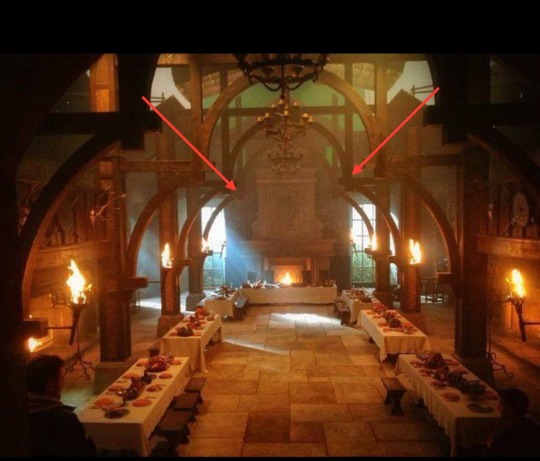
Photo Outlander Season 1 set
Built-in the 13th century, the castle is known for its striking 100-foot-high gatehouse and one of the best-preserved great halls in the country. Its battlements afford stunning views of the River Teith and Ben Lomond. Doune Castle, suffered much damage in the Wars of Independence. It was later rebuilt in its current form in the 14th century by Robert Stewart, Duke of Albany, who is nicknamed the 'uncrowned King of Scotland'. The son of King Robert Il of Scots, and Regent of Scotland until his death.
It has a long and colourful history. Mary Queen of Scots stayed there on several occasions, and Bonnie Prince Charlie used it as a garrison during the Jacobite Rebellion. It fell into disuse after the Jacobites were defeated and by the beginning of the 19th century, was in ruins.
Doune Castle near Stirling was used as Castle Leoch's seat of Clan Mackenzie in Season One of Outlander. It is also Winterfell in Game of Thrones, and featured in Outlaw King and Mary Queen of Scots and and the 1975 comedy film Monty Python and the Holy Grail.
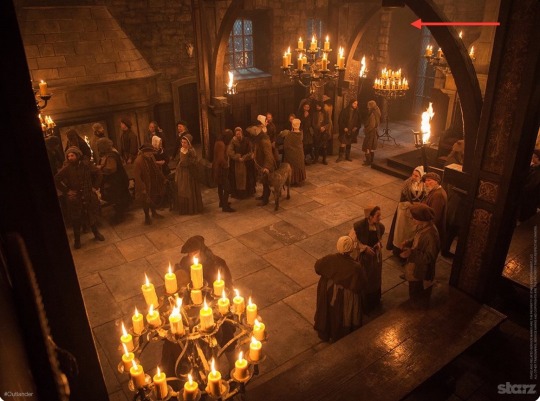
Photo Outlander Season 1 set
From Jeremy's photo it seems that to recreate the new look of BOMB from the 18th century, the set presented looks familiar. It's possible could be working on sets already created by Jon Gary Steele, former production designer on Outlander season 1.
He built a lot of 18th-century interiors retrofitted in Doune Castle, originally built in 1390, which served as the fictional Castle Leoch in Outlander series. Because it’s a historic Scottish landmark, there were/are prohibitions on what they could/can do there. Doune Castle, is one of Scotland’s most iconic heritage attractions.

Photo Outlander Season 1 set
In season 1 of Outlander, Castle Leoch was made very utilitarian. Many people lived there, either inside the premises or right outside it, in shacks and huts. If you watch the video below, BOMB continues along this line. The laird's part of the castle will be very comfortable, but for everyone else, it will make it like it really would have been, not too comfortable.
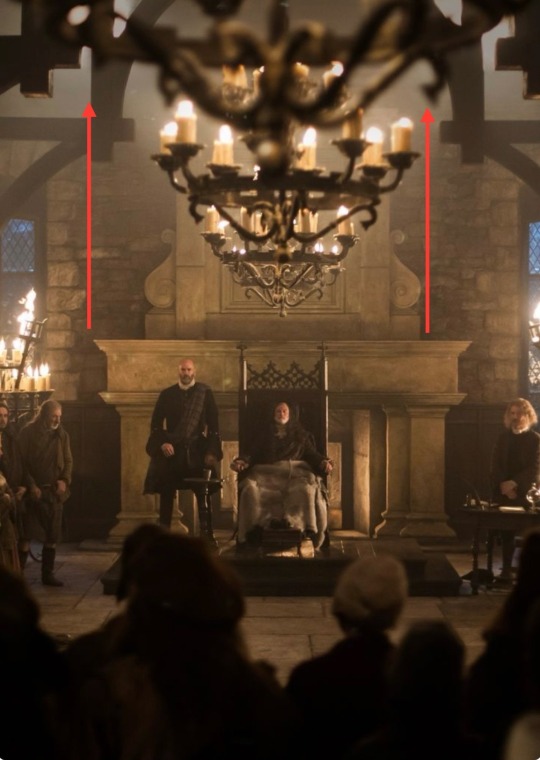
Doune Castle: It is built with exquisite curved wooden beams that give it a touch of elegance and architectural beauty. Raw materials are used in the series in a process that guarantees the integrity of the original structure. The curved laminated wood beams were made in season 1 of Outlander and adorn the Great Hall and continue in BOMB.
Combining craftsmanship and technique, aiming to shed light behind on the remarkable original structural element. In this case, what is missing from the photo is to show how they did it.
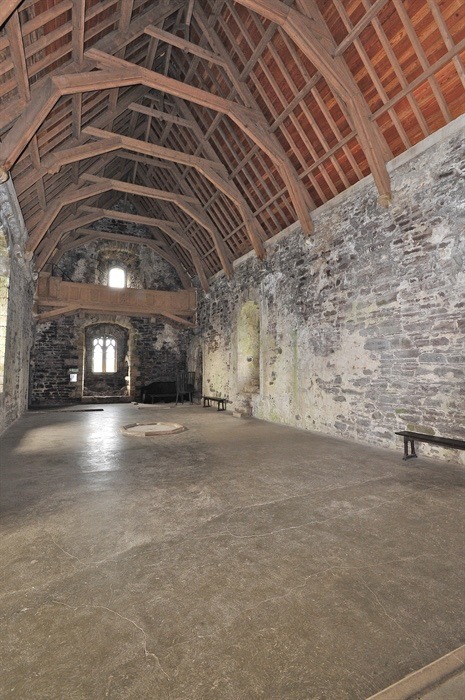
The Great Hall. The castle is known for having one of the best-preserved great halls in the country.

Great Hall interior looks East with arches that follow the curved structure.

Details Doune Castle interior set for filming
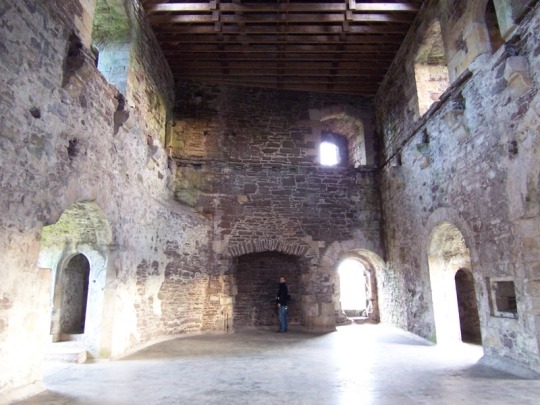
Upper chambers of the Gatehouse Tower
🎥 @ edinburghblackcabtours

Doune Castle will be closed until Wednesday 21 February 2024 for BOMB. filming inside and outside the castle📍
3 notes
·
View notes
Text
wikipedia pages i have looked at recently
(since my browser history cuts off after 3 months)
feudalism
sark
guernsey
jersey
sercquiais
LGBT slang
list of pejorative terms for people
micronation
miso
declaration of war
sophie ellis-bextor
strictly come dancing (series 11)
the weather girls
it's raining men
leg shaving
craig charles
radclyffe hall
cicely mary barker
apennine mountains
gypsy horse
list of crossings of the atlantic ocean
titanic
scullery
dutch elm disease
pince nez
boston marriage
lutheranism
monocle
howards end
list of countries and dependencies by population
academic ranks in the united kingdom
mafia
bad bunny
amber alert
hue and cry
charabanc
list of feminists
skibidi toilet
dj snake
milan kundera
christmas market
darcey bussell
self esteem (musician)
roger eno
squeegee man
crossing sweeper
ramen
housewife
stay-at-home parent
Sally Clark
SIDS
Rabies
catacombs of paris
beaufort scale
religiosity and intelligence
korean variety show
variety show
osbournes reloaded
pine barrens
environment of united states
a walk in the woods (book)
terminal velocity
muzzle velocity
dehumidifier
withnail and i
vivian mackerrell
bruce robinson
2017-18 australian parliamentary eligibility crisis
orlando: a biography
medically unexplained physical symptoms
gulf war syndrome
list of paradoxes
opposite day
cascadia (bioregion)
appalachia
beano (dietary supplement)
idaho
ghost rockets
list of billboard hot 100 number one singles of the 2010s
list of uk singles chart number ones of the 2010s
list of most viewed youtube videos
cardiac tamponade
the spook light
will o' the wisp
atmospheric ghost lights
ball lightening
brown mountain lights
st elmo's fire
poltergeist
shadow person
estimates of historical world population
chin
dan and phil
east west rail
african cuisine
ornimegalonyx
marital rape
bras d'honneur
list of songs by taylor swift
dwarf elephant
bone china
ivory
wrangel island
mammoth
african elephant
last glacial maximum
ground sloth
3D film
nigella lawson
prehistory of australia
mastodon
paleoloxodon
borneo elephant
straight tusked elephant
hyrax
north african elephant
zoetrope
O holy night
containerization
shakira
list of antidepressants
list of poker hands
victoria coren mitchell
bikini
evergreen A-class container ship
i had a little nut tree
gunge
houses in multiple occupation
pedestrian crossings in the united kingdom
belisha beacon
coca-cola formula
demographics of south america
wasabi
flashed face distortion effect
aella (influencer)
temperate rainforest
caledonian forest
loch lomond
bigfoot
jedi census phenomenon
timeline of meteorology
centralia, pennsylvania
jersey devil
ozarks
crawler
blue hole (new jersey)
quantum suicide and immortality
the hum
skyquake
tubal ligation
glycerol
air source heat pump
list of current knights and ladies of the garter
list of prime ministers of the united kingdom
CP Snow
calabash
gourd
apocolocyntosis
1 note
·
View note